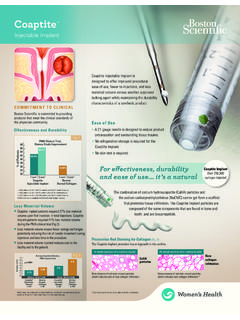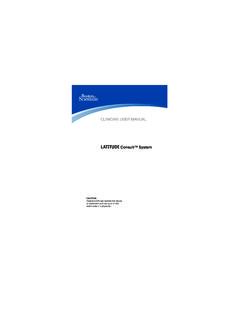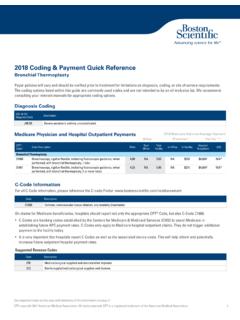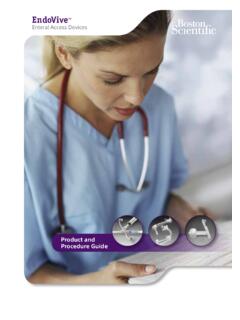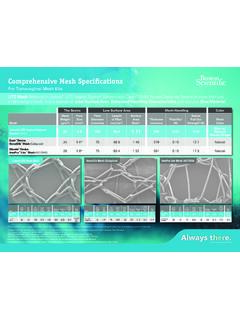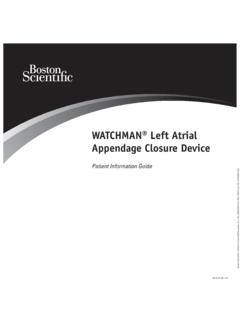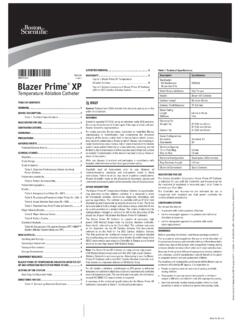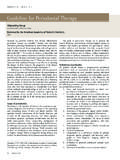Transcription of CLINICAL STUDY SUMMARY ENABLE MRI - Boston …
1 CAUTION: Federal Law restricts this device to sale by or on the order of a physician trained or experienced in device implant and follow-up procedures. CLINICAL STUDY SUMMARY ENABLE MRI TABLE OF CONTENTS CLINICAL STUDY SUMMARY OF ENABLE MRI CLINICAL STUDY .. 1 STUDY DESIGN .. 1 METHODS .. 1 Subject Selection .. 1 Inclusion and Exclusion Criteria .. 1 Inclusion Criteria .. 1 Exclusion Criteria .. 2 ENABLE MRI STUDY Endpoints .. 3 Safety Endpoint .. 3 Effectiveness Endpoints .. 3 RESULTS .. 3 Subject Demographics .. 4 STUDY Endpoint Results .. 5 Safety Endpoint Results .. 5 Effectiveness Endpoints Results .. 6 ADVERSE EVENTS SUMMARY .. 10 DEATH SUMMARY .. 11 CONCLUSION .. 11 The following are trademarks of Boston Scientific Corporation or its affiliates: AUTOGEN, DYNAGEN, IMAGEREADY, INOGEN, and STUDY SUMMARY OF ENABLE MRI STUDY | 1 DESIGN CLINICAL STUDY SUMMARY OF ENABLE MRI CLINICAL STUDYThe ENABLE MRI CLINICAL STUDY was designed to collect data to confirm the safety and effectiveness of the ImageReady MR Conditional Defibrillation System (hereafter referred to as the ImageReady System) when used in the MRI environment under the labeled Conditions of ImageReady System consists of specific Boston Scientific model components including pulse generators, leads, and accessories.
2 The ImageReady MR Conditional Defibrillation System is labeled as MR Conditional as defined by the American Society for Testing and Materials (ASTM),1 when used as a system and in accordance with the labeled MRI Conditions of DESIGNThe ENABLE MRI STUDY was a prospective, non-randomized, confirmatory STUDY at multiple global the STUDY , de novo and existing implant subjects were enrolled and underwent a non-diagnostic STUDY required MR Scan within 6 weeks, for existing implant subjects, or between 6-9 weeks after initial implant or surgical revision of the ImageReady System. Subjects had a STUDY required follow up visit at one month post MRI (MRI + 1 Month Visit). Subjects will be followed annually for 3 years for adverse events and continued evaluation of the ImageReady System SelectionSubjects enrolled in the ENABLE MRI STUDY were selected from the investigators general patient population with an eligible existing ICD/CRT-D or indicated for an ICD or CRT-D implantation.
3 The Investigator was responsible for screening potential subjects and selecting those who met the eligibility criteria for the STUDY . Subjects who consented to be part of the VF Induction Sub- STUDY also were evaluated for the VF Induction Sub- STUDY exclusion criteria at the time of their and Exclusion CriteriaInclusion Criteria Subject was indicated per guidelines and was to receive a CRT-D or ICD system consisting only of the following MR Conditional components* (OR) Subject is implanted with a functional and stable CRT-D or ICD system consisting only of Boston Scientific MR Conditional components. Subject was planned to receive or is implanted with an ICD or CRT-D pulse generator in the left or right pectoral region Subject was able and willing to undergo an MR scan without intravenous sedation Subject was willing and capable of providing informed consent and participating in all testing/ visits associated with this CLINICAL STUDY at an approved CLINICAL STUDY center and at the intervals defined by this protocol1 ASTM Standard F2503-08, Standard Practice for Marking Medical Devices and Other Items for Safety in the Magnetic Resonance Environment ASTM International, West Conshohocken, PA, 2008, DOI: , www.
4 2 | CLINICAL STUDY SUMMARY OF ENABLE MRI STUDY DESIGN Subject was age 18 or above, or of legal age to give informed consent specific to state and national law Exclusion Criteria Subject implanted with an ICD or CRT-D pulse generator with battery at Explant status Subject had other active or abandoned implanted cardiac rhythm devices, components or accessories present such as pulse generators, leads, lead adaptors or extenders. Presence of metallic objects that represent a contraindication to MR imaging at the discretion of the Radiologist and impacting the ability to conduct the STUDY protocol Known or suspected sensitivity to Dexamethasone acetate (DXA) Subject needs or will need a medically necessary MR scan, before completing the 1-month post-MR follow-up visit Subject with: A history of syncope related to brady-arrhythmia A history of syncope of unknown etiology Sinus pauses (Pause > 2 s) Permanent or intermittent complete AV block Documentation of progressive AV nodal block over time Trifascicular block (alternating bundle branch block or PR > 200 ms with LBBB or other bifascicular block)
5 Subject was not clinically capable of tolerating the absence of pacing or Resynchronization therapy support in a supine position for the duration that the pulse generator is in MRI Protection Mode, per Physician discretion Subject was not clinically capable of tolerating the absence of Tachycardia therapy support for the duration that the pulse generator is in MRI Protection Mode, per Physician discretion Subjects with a planned RA, RV or LV lead revision or extraction within 30 days of enrollment Subjects with an implanted lead that was planned to be extracted during the STUDY implant procedure Subjects requiring dialysis Subject with a mechanical heart valve Subject with a known or suspected sensitivity to dexamethasone acetate (DXA) Subject on the active heart transplant list Subject had documented life expectancy of less than 12 months Subject was enrolled in a concurrent STUDY , with the exception of local mandatory governmental registries and observational studies/registries, without the written approval from Boston Scientific Women of childbearing potential who were or might be pregnant, and were to receive an ICD or CRT-D pulse generator CLINICAL STUDY SUMMARY OF ENABLE MRI STUDY | 3 DESIGN ENABLE MRI STUDY Endpoints Safety Endpoint MR Scan-related ImageReady System Complication-Free Rate between the MR Scan and the MRI + 1 Month Visit Effectiveness Endpoints Primary RV Effectiveness Endpoint 1: Increase in RV pacing threshold (at ms) from the pre-MR scan to the 1 Month post-MR Scan Primary RV Effectiveness Endpoint 2.
6 Decrease in RV Sensed Amplitude from the pre-MR scan to the 1 Month post-MR Scan Primary LV Effectiveness Endpoint 1: Increase in LV pacing threshold (at ms) from the pre-MR scan to the 1 Month post-MR Scan Primary LV Effectiveness Endpoint 2: Decrease in LV Sensed Amplitude from the pre-MR scan to the 1 Month post-MR Scan RESULTS Safety and efficacy results through the MRI +1 Month Visit are included in this ENABLE MRI CLINICAL STUDY SUMMARY . A total of 237 subjects were enrolled in the PMA SUMMARY of subject disposition is shown in Figure 1 on the following | CLINICAL STUDY SUMMARY OF ENABLE MRI STUDY RESULTS Figure 1: Subject Disposition Subject Demographics Table 1 summarizes the baseline demographics for the ENABLE MRI subjects. Overall, the average age of the subjects was 65 12 years, with an overall gender ratio of female to male.
7 Table 1: Subject Demographics (N = 237 All Enrolled Subjects) Characteristic Measurement Result Age at Implant (years)Mean SD (Median) Range 65 12 (66) 34-89 Sex [N (%)] Female 65 ( ) Male 172 ( ) BMI (kg/m2) Mean SD (Median) Range ( ) CLINICAL STUDY SUMMARY OF ENABLE MRI STUDY | 5 RESULTS Table 2: Subject Implant Information summarizes the implant information for the ENABLE MRI subjects. Both existing implant subjects and de novo subjects were enrolled. Most subjects were implanted or had a pre-existing CRT-D device (N = 191, ) compared to ICD (N = 39, ). Table 2: Subject Implant Information (N = 230 All Implanted Subjects) STUDY Endpoint Results Safety and effectiveness endpoints are summarized below. Adverse events reported by the investigators were reviewed and classified by an internal committee.
8 All complications reported by the STUDY investigator as related to the MRI scan and all subject deaths were further adjudicated by an independent CLINICAL Events Committee (CEC). Safety Endpoint Results A SUMMARY of the Primary Safety Endpoint result is shown in Table 3. Table 3: Primary Safety Endpoint Result SUMMARY Characteristic Measurement Results PG Type [N (%)] CRT-D 191 ( ) VR ICD 39 ( ) PG Model [N (%)] INOGEN X4 CRT-D 94 ( ) DYNAGEN X4 CRT-D 87 ( ) INOGEN EL ICD 18 ( ) DYNAGEN EL ICD 11 ( ) AUTOGEN X4 CRT-D 10 ( ) AUTOGEN EL ICD 6 ( ) ORIGEN MINI ICD 2 ( ) AUTOGEN MINI ICD 1 ( ) INOGEN MINI ICD 1 ( ) Endpoint Assessment One sided Alpha Performance Result(Confidence Interval) Performance Goal Conclusion Primary Safety MR Scan-Related ImageReady System Complication-Free Rate ( ) 90% Endpoint Met 6 | CLINICAL STUDY SUMMARY OF ENABLE MRI STUDY RESULTS Primary Safety Endpoint: MR Scan-Related ImageReady System Complication Free Rate The Primary Safety Endpoint was assessed for all subjects that underwent any portion of the STUDY -required MR scan sequences.
9 However, if a medically necessary scan occurred between implant and the MRI + 1 Month Visit, data for that subject was not included in this endpoint. Safety was confirmed by evaluating the MR scan-related ImageReady System Complication-free rate (CFR) between the MR Scan and the MRI Visit + 1 Month (calculated as MR scan + 31 days). For the purpose of this endpoint, a MR scan-related ImageReady System complication was defined as those complications that were related to the MR scan and ImageReady System. The MR Scan related complication-free rate through 31 days post MRI Scan was 100% with a one-sided lower confidence limit of 100%. The lower confidence limit is greater than the performance goal of , resulting in a rejection of the null hypothesis. Effectiveness Endpoints Results The effectiveness endpoints were designed to detect a permanent increase in pacing threshold or decrease in sensed amplitude resulting from an MR scan.
10 An MR scan may induce damage to cardiac tissue surrounding the lead distal electrode which is fixated in the myocardium. The potential tissue damage resulting from RF field-induced heating was clinically assessed by evaluating pacing thresholds and sensing amplitudes. Data to support the effectiveness endpoints were measured at the MR Follow-up Visit prior to the MR scan and the Post-MR Follow-up Visit. Three separate consecutive sets of lead measurements were collected at these two visits to reliably determine if a chronic effect and permanent change was induced by the scan. A SUMMARY of the effectiveness endpoints results are shown in Table 4. Details pertaining to each individual endpoint are provided in the following sections. Table 4: SUMMARY of Effectiveness Endpoint Results Primary Effectiveness Endpoint Assessment One sided Alpha Performance Result (Confidence Interval) Performance Goal Conclusion RV Endpoint 1 Pacing Threshold - in-crease in pacing thresh-olds V (at ms) 5% ( ) 87% Endpoint Met RV Endpoint 2 Sensed Amplitude remains mV and above 50% of the value at the MR Follow-up Visit 5% ( ) 85% Endpoint Met CLINICAL STUDY SUMMARY OF ENABLE MRI STUDY | 7 RESULTS Primary RV Effectiveness Endpoint 1: Pre-MR Scan vs.
